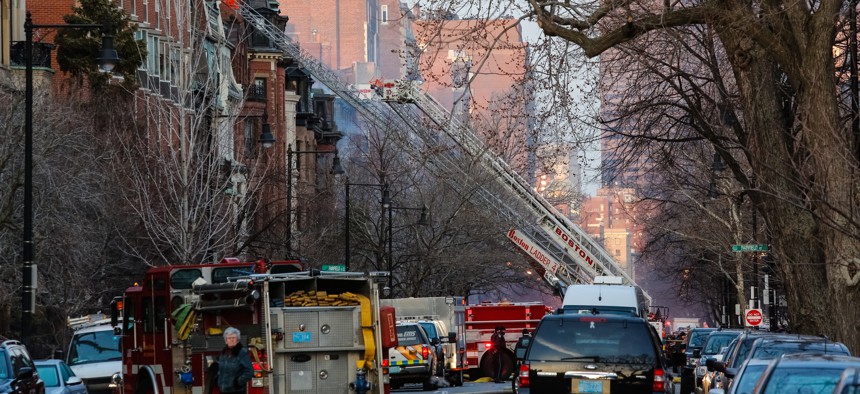AI app fills last-mile GPS gap for responders

GettyImages/ P_Wei
Beans.ai digitized the paper maps responders mark with detailed information on hydrant locations, building exits and other crucial data, ran machine learning algorithms on them, geocoded them and passed them through a human review process to verify the data.
It was Thomas Melia’s first day as acting captain for the Salinas, California, Fire Department (SFD) when a call came in about a blaze at an assisted-living facility.
“I’m nervous right away,” said Melia, an engineer at SFD. “It’s a care facility, so that is a huge red flag for us.”
It’s a three-story building, and finding the affected unit at high-occupancy properties can take precious time. But he used an app from Beans.ai to see exactly where he needed to go. “We were able to get there, ladder it and get the fire out before it spread in the building,” he said.
Before SFD partnered with Beans.ai, a location intelligence company that is working to close what it calls gaps in last-mile information, the problem Melia and his fellow first responders continually encountered was that most GPS apps got them only so far.
“They only have one physical address is the problem you run into,” he said of high-occupancy buildings. “So if you use Google, it will get you to the location, but it won’t get you to the actual door.”
To find the closest door, firefighters relied on binders full of paper maps of buildings. That meant someone on a rig had to consult the physical map and tell the engineer how to get to the exact location of the emergency.
“One of the issues with that is it’s old-school, but also someone doesn’t have their eyes on the road” – a major safety concern when rescue vehicles are racing through traffic, Melia said. Additionally, when a new building went up or was renovated, binders had to be reorganized by hand. SFD has separate binders for each of three districts and each SFD vehicle has one. Extrapolated out, that’s a lot of manual effort.
A couple years ago, the team at Beans.ai, based about 76 miles from Salinas in Palo Alto, California, approached SFD about digitizing those maps. It scanned them, ran machine learning algorithms on them, geocoded them and then passed them through a process of human and machine review to verify the data before giving it back to the department through an app.
The maps include details on where units or offices are located, the closest access doors and where to find gas or electricity shut-offs and stairways. According to Beans.ai’s website, its map gets responders to within 10 feet of their destination.
“It gets you to the closest parking spot to the destination,” Melia said. “It saves you a lot of time.”
Beans.ai’s mapping works on any mobile device and integrates through application programming interfaces with first responder systems including computer-aided dispatch and incident response.
“Fire departments just literally have to talk to their incident response system to turn on the Beans feature layer so that our data can start showing up,” said Akash Agarwal, co-founder and chief business officer at Beans.ai.
The company also offers Map Makers, a GIS tool with micro-tagging capabilities that lets users draw and maintain incident plans. For instance, responders can mark unit locations, fire hydrants and handicapped entrances, and it’s automatically shareable.
So far, the company has mapped about 11 million apartments in about 70% of places with at least 20 units, and it expects to have 100% mapped within six months.
Beans.ai gets its data in several ways. One is by scanning paper maps, whether they are from fire departments, building managers, leasing offices or other public sources. It also downloads publicly available maps. Third, the company works with a network of about 1,400 delivery drivers who request maps when they make deliveries, and anyone using the app can upload data about locations by dropping a custom pin on the map and noting what it indicates, such as a fire hydrant location. The company pays users $6 to $8 per map if they upload one the company didn’t already have.
Right now, Beans.ai is launching pilots for indoor mapping, especially at hospitals and condos, for navigation but also to help firefighters determine the best flight paths for drones. In Chicago and Houston, it is testing the creation of 3D maps. “If you are responding to an emergency in a high-rise, sometimes it becomes really hard for the other firefighters or first responders to find the first, first responder who went inside the building,” Agarwal said.
Additionally, the company is working to fine-tune its integration with 911 dispatch centers so that dispatchers can guide responders who are en route. For example, they can say, “You will see three buildings. Go to the one on the right and around the back.”
Agarwal and Nitin Gupta started Beans.ai three years ago after noticing that delivery drivers struggled to find their apartments – and when it took paramedics 24 minutes to find Gupta’s mom during a medical emergency. They took jobs with Uber Eats and Door Dash and found that the problem was in navigating high-density campuses. SFD was the first fire department it worked with.
Stephanie Kanowitz is a freelance writer based in northern Virginia.





